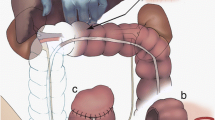Summary
Initial reports with limited follow-up suggested that the ileal hydraulic valve was a satisfactory approach to continent urinary diversion that was associated with acceptable early complication rates and uniform efficacy in achieving continence. We sought to evaluate the later outcomes of patients with this form of continent urinary diversion. An average extended follow-up of 5 years was available on 11 patients who had undergone ileal hydraulic valve diversion. Although only 13% of patients had complications requiring surgical revision at 18 months of follow-up, at the 5-year follow-up, 91% had developed complications requiring surgical revision. Of these, 64% entailed major revision of the urinary diversion. The most common late complication was stomal stenosis (73%); calculus formation (36%) and devagination (36%) were also common. Although in some cases, stomal stenosis was successfully managed by superficial revision with skin flaps and grafts, most cases required complete replacement of the efferent limb. Use of the devaginated or stenosed ileal hydraulic valve to construct a flap-valve efferent limb based on the Mitrofanoff principal succeeded in salvaging the continent urinary diversions in these patients. Novel forms of urinary diversion require extended follow-up for accurate assessment of their feasibility and efficacy. Attentive surveillance with surgical revision as necessary in such cases is mandatory for the preservation of continence and renal function.
Similar content being viewed by others
References
Benchekroun A, Essakalli N, Faik M, Marzouk M, Hachini M, Abbakka T (1989) Continent urostomy with hydraulic ileal valve in 136 patients: 13 years of experience. J Urol 142:46
Duckett JW, Snyder HM III (1986) continent urinary diversion: variations on the Mitrofanoff principle. J Urol 136:58
Gearhart JP, Peppas DS, Jeffs RD (1995) The application of continent urinary stomas to bladder augmentation or replacement in the failed exstrophy reconstruction. Br J Urol 75:87
Keating MA, Rink RC, Adams MC (1993) Appendicovesicostomy: a useful adjunct to continent reconstruction of the bladder. J Urol 149:1091
Kock NG, Nilson AE, Nilsson LO, Norlen LJ, Philipson BM (1982) Urinary diversion via continent ileal reservoir: clinical results in 12 patients. J Urol 128:469
Leonard MP, Quinlan DM (1991) The Benchekroun ileal valve. Urol Clin North Am 18:717
Leonard MP, Gearhart JP, Jeffs RD (1990) Continent urinary reservoirs in pediatric urological practice. J Urol 144:330
Middleton AW, Hendren WH (1976) Ileal conduits in children at the Massachusetts General Hospital from 1955 to 1970. J Urol 115:591
Mitchell ME, Yoder IC, Pfister RC, Daly J, Atlhausen A (1977) Ileal loop stenosis: a late complication of urinary diversion. J Urol 118:957
Mitrofanoff P (1980) Cystostomie continente trans-appendiculaire dans le traitement des vessies neurologiques. Chir Pediatr 21:297
Quinlan DM, Leonard MP, Brendler CB, Gearhart JP, Jeffs DR (1991) Use of the Benchekroun hydraulic valve as a catheterizable continence mechanism. J Urol 145:1151
Rowland RG, Mitchell ME, Bihrle R, Kahnoski RJ, Piser JE (1987) Indiana continent urinary reservoir. J Urol 137:1136
Schwarz GR, Jeffs RD (1975) Ileal conduit urinary diversion in children: computer analysis of follow-up from 2 to 16 years. J Urol 114:285
Shapiro SR, Lebowitz R, Colodny AH (1975) Fate of 90 children with ileal conduit urinary diversion a decade later: analysis of complications, pyelography, renal function and bacteriology. J Urol 114:289
Skinner DG, Boyd SD, Lieskovsky G (1984) Clinical experience with the Kock continent ileal reservoir for urinary diversion. J Urol 132:1101
Winslow BH, Jordan GH (1989) Continent cutaneous stoma. Dial Pediatr Urol 12:2
Author information
Authors and Affiliations
Rights and permissions
About this article
Cite this article
Sanda, M.G., Jeffs, R.D. & Gearhart, J.P. Evolution of outcomes with the ileal hydraulic valve continent diversion: reevaluation of the Benchekroun catheterizable stoma. World J Urol 14, 108–111 (1996). https://doi.org/10.1007/BF00182567
Issue Date:
DOI: https://doi.org/10.1007/BF00182567




